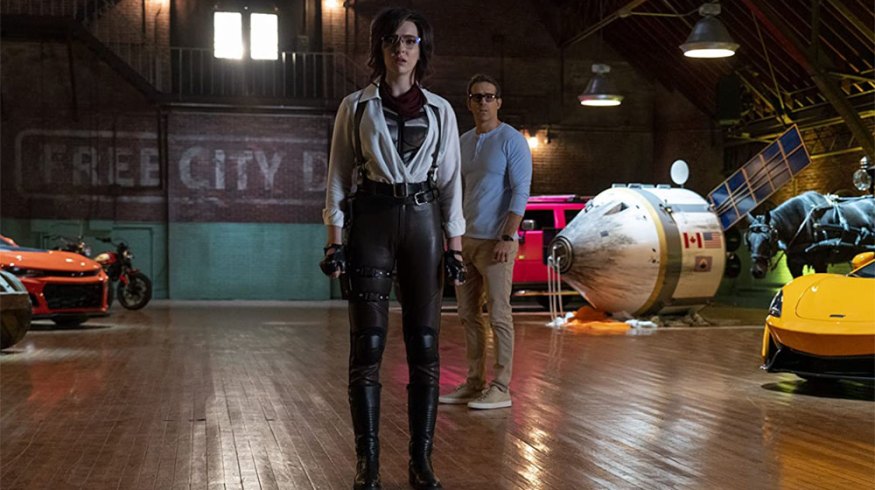
How to Speak Science Fiction: A Field Guide
So you want to make a science fiction movie? Here’s your field guide to the genre’s tricks, tropes, and tribulations.
Let’s start at the beginning—say a long time ago in a galaxy far, far away. Well, no, that’s not far enough back. There’s some debate on the internet (imagine that!) about the truly first science fiction story.
Some give that credit to Mary Shelley for Frankenstein or The Modern Prometheus (1818), while others say the Oscar goes to Johann Valentin Andreae’s The Chemical Wedding, a fantastical story of Rosicrucianism (1616).
The point is, way back, we started bringing what we can loosely call “science” into our stories. It hadn’t really been a thing all that long—science—so the narrative traditions of the Renaissance and the Enlightenment hadn’t really caught up to all the “science fiction” rage. Our tales of gods and monsters started involving chemistry and electricity. The world was modernizing, so fiction was too.

There are myriad sub-genres and sub-sub-genres under the science fiction umbrella. We shan’t go too deep down that rabbit hole because that way lies madness, but suffice it to say that trends and movements have been shaping science fiction from the beginning.
A common misperception is that science fiction reflects the future. It doesn’t. (That’s impossible.) Science fiction is usually social commentary turning a critical lens on our world today, so the sturm und drang of culture, conflict, technology, and just about any other human endeavor you can think of nudge the genre (and its sub-genres) this way or that.
Science fiction is a roiling, excitable, political place full of heroes, technological advancements, scum, and villainy. So, in the interest of time and space (see what I did there?), let’s restrict our survey to just a few sub-genres . . .
Science Fiction
Trying to define science fiction is a rat’s nest. As soon as you establish parameters about what is and what isn’t SF, you start excluding things. That means experimental or cross-genre work starts getting cut out, even though this is the type of work that usually drives the genre forward.
What’s more, canonical science fiction often brings its gravitas from hegemonic traditions, which means anything that doesn’t fit this orthodox definition isn’t “pure,” and that’s definitely not what we want to be saying about works of science fiction coming from traditionally under-represented sources.

The tradition of science fiction cinema has its roots in literature, but it is, of course, its own branch of the family tree. That being the case, let’s consider a definition from the literary tradition so we can at least start having this conversation. A commonly cited definition comes from Darko Suvin in 1972:
[A] literary genre whose necessary and sufficient conditions are the presence and interaction of estrangement and cognition, and whose main formal device is an imaginative framework alternative to the author’s empirical environment.
There’s a bit of critical hand-waving going on here—feel free to google the quote and start unpacking what other people think Suvin means.
Let’s take it to mean, roughly, fiction set in a world that isn’t quite this world (or is wholly different) that’s recognizable enough to operate mostly by our laws of physics, with rational imaginations of technology, culture, or life. That should give us a broad enough canvas to work with—in any larger context, that definition has as many holes as your favorite colander, so bear with me.
Okay—one sort of down. Next science fiction sub-genre to consider . . .
Science Fantasy
I mean, I said this was going to be a rat’s nest. So, Going down. Next level: blurrier definitions.
Science fiction and fantasy are often considered two genres, even though you hear that phrase, “science fiction and fantasy,” as one inviolable unit all the time. Pure science fiction and pure fantasy are easy to differentiate. In the words of Rod Serling, science fiction is “the improbable made possible,” while fantasy is “the impossible made probable.”
In other words, science fiction is a scientifically possible story—at least based on extrapolation. Fantasy, which we’ll look at in more detail in another post, relies on elements of the supernatural that simply aren’t possible in our universe.

Science fantasy thumbs its nose a bit at these rules. In a work of science fantasy, the world functions scientifically, even if it includes elements of the supernatural. Those elements may be impossible in our universe, but they’re scientifically explicable in a fictional one.
Dune is a good example. Everything in this story functions plausibly, based on the rules it presents, which are mostly our rules of the universe. However, cool magic-like effects are the result of physical and mental conditioning—not to mention the eponymous spice, mélange.
If science fiction is wearing a suit and tie to the party, science fantasy has already unbuttoned its collar and is sneaking people in through the kitchen.
Cyberpunk
What isn’t to love about cyberpunk? The apocalyptic cityscapes, the randomly smoking buildings, the glitz and flash of the technological world—and the murder, mayhem, addiction, and intrigue, of course.
Cyberpunk has its origins in the New Wave science fiction movement of the 1960s and ’70s, when writers began exploring the confluence of drug culture, dystopian society, and technology.
Cyberpunk explored the underbelly of the at-the-time-seemingly-limitless potential of the tech age, and it resisted earlier science fiction tendencies toward a utopian society. According to cyberpunk, the world is a hard-edged place, and it’s only going to get harder as we continue evolving.

The term comes from early cyberpunk author Bruce Bethke, who wrote a story by that title in 1980. A seminal example of the sub-genre, both in literature and film, is Ridley Scott‘s Blade Runner, based on the proto-cyberpunk novel by Philip K. Dick Do Androids Dream of Electric Sheep?
Both media have the iconic post-economic-apocalypse, dingy-living, technologically-dependent cynicism that would come to define the sub-genre.
Cyberpunk happens when humans meet technology and bring their worst habits with them. The Age of the Internet has only made this sub-genre more acute.
Space Opera
Space opera isn’t what it sounds like. For starters, there’s no opera. Usually, there’s no singing of any kind.
This sub-genre has undergone its fair share of definitions, just like the others. It didn’t really formalize until the early 1990s, but the content was there long before.
In film, the sub-genre probably began with the 1918 Danish proto-space opera film, Himmelskibet, about a trip to Mars. Without digging our way through every definition throughout its lifespan, we can summarize space opera like this: melodramatic science fiction about interstellar warfare using advanced technology.
It differs from formal science fiction in that it’s purely about drama and adventure—there’s little room for philosophy or social commentary in space opera.

The sub-genre really got its start in the 1920s and 1930s in pulp science fiction magazines that writer Wilson Tucker called “hacky, grinding, stinking, outworn, spaceship yarn[s],” which he dubbed space operas. The term derives from soap operas, which were originally serial radio dramas sponsored by soap companies. It also shares some etymology with horse opera, which indicated a formulaic western film.
Space operas are big movies about big ships hunting each other in the vastness of space with grossly exaggerated technological weaponry. To return to our dinner party, science fiction is wearing the suit and tie, science fantasy is doing Jell-O shots at the bar, and space opera is wearing spurs and lighting cigarettes with a lightsaber.
Why Choose Science Fiction?
There are plenty of reasons to make a science fiction movie. Even when they’re horror-themed, they’re still just cool because, you know, future.
Science fiction films carry the veneer of reality, so there’s a probability, a believability to their storylines that we don’t necessarily assume when watching other genres. And the assumptions we make are just as much a part of the genre-viewing experience as the movie you make. Teaching your audience how to watch your movie is important, but that’s a conversation for another time.
Science fiction brings the imagination unfettered by today’s technological limits. We can construct near- or far-future scenarios wherein anything is possible simply because, as Arthur C. Clarke told us, “Any sufficiently advanced technology is indistinguishable from magic.”
All we have to do is dream it up, and we can claim that the future will be capable of making it real. That’s totally different from the suspension of disbelief inherent in supernatural or fantasy films.

Another reason mentioned briefly above is the backward lens. We’re ostensibly watching stories about the future—we’re watching the consequences of our actions today, whether environmental, political, or technological. The people in the future reflect what we’ve created for them. Put another way, the watchers from the future are looking backward at us.
While we’re 100% not actually creating documentaries about future people, we’re definitely projecting today’s realities onto a . . . well, screen.
Science fiction lends itself well to commentary. What happens if we take nuclear technology too far? Should we really be trying to travel in time? Just how smart should we make the machines? We build science fiction out of ourselves. If you have something to say with your movie, and you don’t want to force it down our throats, try science fiction!
Not every sci-fi movie needs to be message fiction, but it can be, and when we sit down for this genre, we’re usually inclined to listen.
The Science Part
The one hard part about science fiction is the science. The laws of physics need to function the same in your movie world as they do in the real one. That means scientific instruments and technologies operate according to a set of rules. Highly sophisticated, complex, and weird rules. So, you have some options . . .
You can go the hard science fiction route and back up every line of dialogue and every action in your film with thoroughly researched and proven science. This can be tricky if you’re a younger filmmaker or simply just not a physicist.
If you have a large enough budget, you can pay experts to help you figure these parts out. Without said budget, you’re relegated to Wikipedia and Google.
(Star Trek: The Next Generation is famous for its “technobabble.” The writers even began simply writing “tech” in the scripts in the hopes that science advisor André Bormanis would come along later and fill in the details.)

Alternatively, if, as they say, the devil is in the details, then stay away from them. There are tried-and-true tenets of science fiction that you can intone without reinventing the wheel—faster-than-light travel, advanced weaponry, enhanced medical science, cybernetics, etc.
When you think about science fiction movies, generally speaking, you’re going to think of these neat tricks—everyone is. You can use that to your advantage, wave your wand with “you know, it just works,” and concentrate on your story or message.
Science Fiction on a Budget
It might seem counter-intuitive, but science fiction lends itself well to low-budget or DIY projects. We tend to think that a proper science fiction production involves many effects—and that means a budget. It certainly can mean this, but it also doesn’t have to. Don’t be misled into thinking that to do a science fiction project, you have to dress it up enough to compete with Hollywood blockbusters.
The technologies and innovations that make science fiction, well, science fiction, aren’t real. So, sure, the flux capacitor in Doc Brown’s DeLorean is cool-looking, but so is Hal-9000, and we’re supposed to believe it’s a malevolent, super-intelligent computer system. I once made a Halloween costume by gluing a small, red bowl to a white T-shirt and told everyone I was Hal, so . . .

What I’m saying is, the on-screen representations of your technological advancements can be subtle, simple—they can even be cheap (and often are, for most indie projects). Hide the details. Use lights and sound design. Create minimal props that are easy to mess with in After Effects.
You can create powerful stories in empty buildings and isolated spaces that could be set now or in the future. A garden shed can be an apocalypse bunker. A storm shelter can be an alien prison. Heck, John Carpenter used a beach ball as an alien in Dark Star, and no one seems to care.
Science fiction in the hands of indie filmmakers is truly where imagination thrives. Google the creation of sound effects for Star Wars, way back. You’ll see what I’m talking about.
DIY
In that spirit of imagination and innovation, tutorials are your friends, and the PremiumBeat YouTube channel has just about everything you could dream up on your science fiction set. Here are just three examples to get you started.
Stay on the sci-fi train with these gems:
- How Denis Villeneuve’s Blade Runner 2049 Perfected the Art of Color Theory
- 7 Core Genre Elements Every Zombie Movie Needs
- The Ins and Outs and Ins and Outs of Creating a Time Loop Film
- Go Medieval With These Easy-to-Make Fantasy Props
- Break Genre Rules Like a Master Filmmaker
Cover image via 20th Century Studios.





